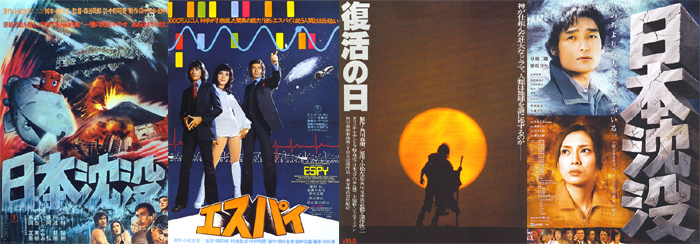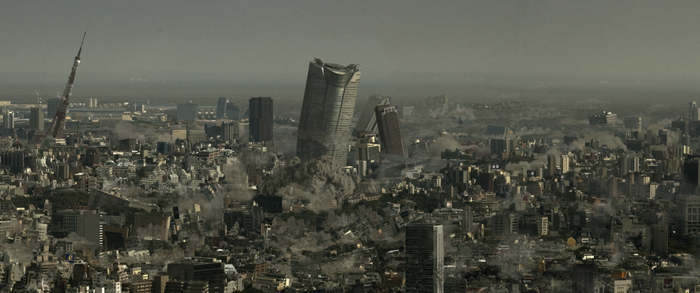 Author Sakyo Komatsu`s novels were adapted into several popular Japanese films. SUBMERSION OF JAPAN and ESPY © Toho Co., Ltd. VIRUS © 1980 Haruki Kadokawa Films. SINKING OF JAPAN © 2006
Author Sakyo Komatsu`s novels were adapted into several popular Japanese films. SUBMERSION OF JAPAN and ESPY © Toho Co., Ltd. VIRUS © 1980 Haruki Kadokawa Films. SINKING OF JAPAN © 2006 Prolific Sci-Fi Author Passes Away at Age 80 Authors: Andrew Nguyen and Keith Aiken Source: Nippon 2007, Science Fiction Studies, Mainichi Daily News, various
Japan’s science-fiction community lost one of its grand figures recently with the passing of Sakyo Komatsu on July 26, 2011 from pneumonia. Born January 28, 1931 in Osaka, Komatsu graduated from Kyoto University with a degree in Italian Literature in 1954. In 1961 he entered the Hayakawa Science Fiction Competition, a story contest co-sponsored by Hayakawa Library, publisher of SF Magazine (SF Magajin), and the Toho Motion Picture Company. He received an Honorable Mention and 5000 yen for his entry Peace on Earth (Chi-ni Heiwa), a World War II story set in an alternate timeline where Japan did not surrender in the wake of the atomic bombings. The next year, Komatsu won the contest with his story Memoirs of an Eccentric Time Traveler (Ekisentoriki), which was published in SF Magazine. Sakyo Komatsu soon became one of Japan`s most prolific and popular science fiction writers. In 1963, he did his first work in the film industry with some uncredited contributions to the story treatment for Toho’s horror film MATANGO, and his story The Taste of Green Tea Over Rice (Ochazuke no Aji) was nominated for the Naoki Prize (Naoki Sanjugo Sho) by the Society for the Promotion of Japanese Literature (Nihon Bungaku Shinko Kai). His first novel, The Japanese Apache (Nihon Apachi Zoku) sold 50,000 copies in 1964 and was soon followed by Day of Resurrection (Fukkatsu no Hi). The following year, Espy (Esupai) was serialized in Weekly Manga Sunday magazine, and Komatsu worked on the treatment for Tsuburaya Productions` unmade television series WOO. 1966 saw the acclaimed At the End of an Endless Stream (Hateshi Naki Nagare no Hate Ni). Komatsu`s most famous novel was Japan Sinks (Nihon Chinbotsu), in which the shifting of the tectonic plates resulted in earthquakes across the entire nation and causes all of Japan to crumble into the sea. The book was published in March, 1973 and was a massive hit, selling over 4 million copies in Japan alone. The novel won the 27th Annual Japan Mystery Writers’ Association Award and the Japanese National Science Fiction Convention`s Seiun Award, was translated into a dozen different languages, and received positive reviews from foreign press like The New York Times and The Christian Science Monitor. An English language edition of Japan Sinks was released in the US in 1976. A second edition appeared in the US in the aftermath of the 1995 Kobe Earthquake with a new opening statement by the author.
The same month that Japan Sinks first arrived on store shelves, Toho announced their plans to bring the story to the big screen as SUBMERSION OF JAPAN (Nippon Chinbotsu). Sakyo Komatsu recalled, "I felt so obligated [to Toho for helping launch his career with the Hayakawa Science Fiction Competition] that in 1973 when we were discussing a film version of Japan Sinks, I gave them the movie rights with almost no conditions. I think they paid 1.5 million yen." Budgeted at a then-high Y500 million (approximately $3 million US) and running 140 minutes, SUBMERSION OF JAPAN was released December 29, 1973 and followed the phenomenal success of its source material. The movie sold 6.5 million tickets and took in $14 million at the box office, making it the highest grossing Japanese film in the country’s history up to that time. Toho issued a 113 minute cut of the film for international sales, and an English dubbed and heavily edited version was shown in the United States as TIDAL WAVE in 1975. Toho announced plans for a second movie, CONTINUATION: SUBMERSION OF JAPAN (Zoku Nippon Chinbotsu), but instead partnered with the Tokyo Broadcasting System to produce a SUBMERSION OF JAPAN television series which debuted on October 6, 1974. In the wake of SUBMERSION OF JAPAN, Sakyo Komatsu’s stories continued to be popular subjects for films. Toho made ESPY (Esupai, 1974), and Haruki Kadokawa Films produced VIRUS (Fukkatsu no Hi, based on Komatsu’s Day of Resurrection, 1980), the most expensive movie made in Japan up to that time. Komatsu also produced and co-directed Toho’s SAYONARA JUPITER (Sayonara Jyupita, 1984), adapted from his Seiun Award-winning 1983 novel of the same name. But critics and audiences alike found SAYONARA JUPITER a long and boring example of creative overindulgence and it failed at the box office. The disappointment of SAYONARA JUPITER had little impact on Komatsu’s busy schedule. He wrote an astounding amount of fiction, non-fiction, and poetry, and continued to win award after award. From 1980-1983, he was president of the Science Fiction and Fantasy Writers of Japan and worked with author Yasutaka Tsutsui (Dreamtree Hill Junction, Salmonella Men on Planet Porno) to create the organization’s Grand Prize for Japanese SF (Nihon SF Taisho). In 1985, Komatsu’s novel The Capital Vanishes (Shuto Shoshitsu) won the SFFWJ Grand Prize award. Five years later, he helped plan the International Gardening and Greenery Exposition in Osaka. At the start of the new millennium, he launched Sakyo Komatsu Magazine (Komatsu Sakyo Magajin). More recently, the “King of Japanese SF” was Guest of Honor at Nippon 2007, the first Worldcon (World Science Fiction Convention) ever held in Japan. Japan Sinks returned to the big screen in 2006 with director Shinji Higuchi`s adaptation, SINKING OF JAPAN (Nihon Chinbotsu). While receiving mixed reviews the film was a box hit hit. In interviews shortly before his death, Sakyo Komatsu expressed his faith that Japan would recover from the the devastating earthquake and tsunami which struck this past March 11th.
 Disaster strikes in SINKING OF JAPAN, the latest film version of Koamtsu`s novel. Photo courtesy of The Associates. © 2006
Disaster strikes in SINKING OF JAPAN, the latest film version of Koamtsu`s novel. Photo courtesy of The Associates. © 2006 


